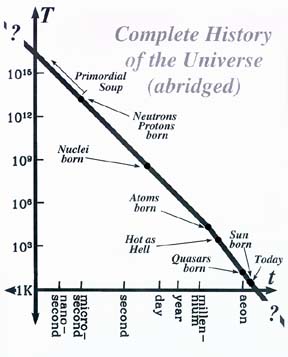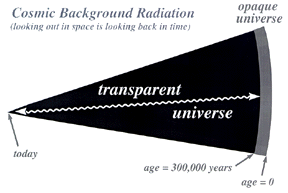The Universe TodayToday the universe is about twelve-billion years old, with a cosmic temperature of 3 K. When our sun formed, some five-billion years ago, the universe was seven-billion years old, with a cosmic temperature of 4 K. We can see what the universe was like seven-billion years AB, because we can look back in time by looking out into space. Since light has a finite velocity, when we observe distant objects we see them as they existed in the past, when the light we now observe was emitted from the object. For instance, the sun is eight light-minutes away from Earth, so when we stand on Earth and look up, we observe the sun as it existed eight minutes before we "see" it. The nearest large galaxy is Andromeda, some two-million light-years distant. When we observe Andromeda, we see it as it existed two-million years ago when the light reaching us now started its journey. The lesson is simple: looking out in space is looking back in time. The more distant the object, the further back in time we are able to probe. Looking out in space, looking back to the time in the history of the universe when our sun formed, we find that the spatial density of galaxies was about three times the present density of galaxies in space (although the internal densities of galaxies have not changed). The universe was indeed denser in the past. We can look much deeper into space than the distance corresponding to seven-billion years AB. The most distant astronomical objects we observe are quasars. Quasars are very bright objects that we believe signal the birth of galaxies. When we look at very distant quasars we can sample the universe when it was only one-billion years old and the cosmic temperature was 16 K. Although 16K is hot compared to the present cosmic temperature, it is still incredibly cold. We have to journey back much earlier in the history of the universe to find warmer conditions. About fourteen-million years AB the temperature of the universe was about the freezing point of water. Two-million years earlier than that, about twelve-million years AB, the primordial fireball was a temperature very pleasant for humans (although humans were not around to enjoy it). But the comfort zone only lasted a few-million years. Earlier than nine-million years AB the temperature was above the boiling point of water. Three-million-three-hundred-thousand years AB the temperature of the universe was truly hellish, assuming the temperature of hell is around the boiling point of brimstone, T = 445oC = 833oF. Cosmology suggests that hell was in our past, not in our future.
Figure 2: An abridged history of the universe. The universe was really cooking three-hundred-thousand years after the bang, when the temperature of the universe was about 3000 K. This epoch in the history of the universe was the true birth of the atomic age. Earlier than three-hundred-thousand years AB, when it was hotter than 3000 K, atoms could not exist because there was enough hot thermal radiation to ionize any atoms (strip the negatively charged electrons from the positively charged nuclei). For the first three-hundred-thousand years the universe was a hot plasma of positively charged nuclei and negatively charged electrons. Electromagnetic radiation (e.g., light) cannot travel unimpeded through a dense plasma, so the universe was opaque for its first three-hundred-thousand years. The universe became transparent to electromagnetic radiation only after atoms formed. The cosmic background radiation last interacted with matter during the formation of atoms, so the microwave photons are a direct relic of the universe at this time and we can "see" the universe three-hundred-thousand years AB by studying the microwave background radiation. Since the universe was opaque for the first three-hundred-thousand years of its life, we cannot use light of any wavelength to look out in space to a time earlier than three-hundred-thousand years AB.
Figure 3: Looking out in space is looking back in time. Although we can not observe directly the universe for its first three-hundred-thousand years, we can simulate the early universe by recreating the conditions of the early universe in the laboratory. If we can discover the fundamental forces and particles relevant for the extreme conditions of density and pressure present in the early universe, we can understand the evolution of the early universe. The simulation of the early universe uses the familiar equation of Einstein's theory of gravity: Rμv - ½μvR = 8пGTμv. One does not have to be a physicist to grasp the pertinent feature of this equation: it has a left-hand side and a right-hand side. The way I have cleverly written the equation (also the way Einstein wrote it), the left-hand side describes space and time - the curvature of space and the expansion of space. The right-hand side describes the fundamental particles and forces, and how matter and energy is distributed throughout the universe. The left-hand side and the right-hand talk to each other. The curvature of space and the expansion of space tell matter how to move, and the fundamental forces and the arrangement of the fundamental particles tell space how to curve and how to expand. So if we can understand the right-hand side of the equation, the fundamental particles and forces, we can use the Einstein equation to study the evolution of the early universe. Here we see the inner-space/outer-space connection at work. Microphysics determines the evolution of the universe.
Contributed by: Dr. Edward Kolb |







